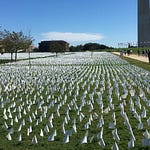“There’s a great category of history books that simply refresh our memory” -Clay Risen
If you went to high school in the United States and took an American history class, chances are at the end of the school year you learned about Joseph McCarthy and the Red Scare of the 1940s and 1950s. Indeed, readers of a certain age lived through the scare and, perhaps, have some memories of it.
But that’s the irony of such a consequential period in the American past, which began roughly 80 years ago; the memories of it have come down to us as a sort of décollage, short fragments of stories ripped and unstuck from their original time and place, and pieced back together as fragments in textbooks and movies. Alger Hiss, Ethel and Julius Rosenberg, Robert J. Oppenheimer… our collective memory knows some of the names affected by the inquisition. In reality, there were thousands of American lives destroyed by a hysteria that swept through government and the broader American public during the early years of the Cold War.
A new book by Clay Risen, a journalist at the New York Times, seeks to refresh our memories on the wide panoply of Americans whose lives were forever changed by the actions of their own government and their peers. They included:
The executive secretary of a small, New York–based charity that raised funds for victims of the Spanish Civil War;
A screenwriter who had worked the night shift at a commercial bakery for eight years;
A government scientist who was the director of the National Bureau of Standards at the U.S. Department of Commerce;
An openly gay man who served in both the U.S. Department of State and CIA—one of thousands of gay men and women removed from federal service under the pretense of being a “security risk”;
A China scholar at Johns Hopkins University;
A medical doctor who devoted part of his career to humanitarian work overseas;
One of the best math teachers in the U.S., along with his wife.
While Americans from numerous walks of life were targeted, government employees were a particular focus. Thousands of government employees alleged of having ties to the Communist party, accused of being a security threat, or suspected of being homosexuals were fired or forced to resign as part of a sweeping effort to secure “loyalty” throughout the federal workforce.
A select few individuals inside government and broader American society were, actually, Soviet spies. The vast majority were not; they were activists, journalists, academics, educators, librarians and government workers who lost their jobs, lost their licenses, were blacklisted from their professions and, in some cases, sentenced to prison. They were targeted by the House Un-American Activities Committee in the U.S. House of Representatives and Senator Joseph McCarthy (R-WI) in the U.S. Senate, both of whom aggressively investigated alleged, perceived or imagined threats while simultaneously advancing their own careers.
While the investigations were led by Congress, the affected individuals were largely penalized by their own peers. Hollywood executives who feared or sympathized with the witch-hunts prevented their colleagues from landing work; school boards or teachers unions barred their fellow educators from teaching or renewing their licenses; and government agencies preemptively fired their employees whenever they drew the attention of investigators. The tragedy of the Red Scare was that the fear of being in the crosshairs of government became more powerful than the government itself.
In my conversation with Clay, presented above as a podcast, we talked about some of the Americans whose lives were forever changed by the Red Scare, and the resonances with what is happening today around the world as educators, scholars, journalists, government employees and activists are, again, being labeled as “dangerous” and “subversive.” We also talked about efforts during the 1940s and 1950s to ban and burn books at schools and libraries. At one point, Senator McCarthy targeted overseas libraries run by the U.S. Department of State, which were intended to showcase America’s commitment to free speech. McCarthy alleged these libraries contained thousands of “dangerous” books by individuals aligned with Progressive causes or the political Left. Books were removed and library directors were forced to resign. Similar scenes unfolded in schools nationwide, with books banned in Georgia and books burned in Oklahoma. Thousands of teachers left the profession, and others were scared into silence. As Clay recounts:
“Far more to be feared than any radicalism in our schools is the tyranny that would force education into a straight-jacket of regimented conformity,” said Reverend Walter Tunks, the rector of St. Paul’s Church in Akron, Ohio, at the National Education Association’s 1953 convention in Miami Beach. “That is the real threat to our American way of life.”
The book is titled Red Scare: Blacklists, McCarthyism, and the Making of Modern America and more information about Clay Risen is on his website. I hope you’ll listen to our conversation, and that it might offer some food for thought on our current times.
Have a good week,
-JS














Share this post